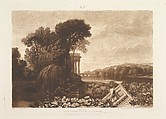Isis, part XIV, plate 68 from "Liber Studiorum"
Designed and etched by Joseph Mallord William Turner British
Engraver William Say British
Publisher Joseph Mallord William Turner British
Not on view
Turner distilled his ideas about landscape In "Liber Studiorum" (Latin for Book of Studies), a series of seventy prints plus a frontispiece published between 1807 and 1819. To establish the compositions, he made brown watercolor drawings, then etched outlines onto copper plates. Professional engravers usually developed the tone under Turner's direction, and Say here added mezzotint to describe a subject based on a painting of 1804-5 bought by the Earl of Egremont for Petworth House, traditionally titled "The Thames at Weymouth." In fact, the image does not represent a specific place, but combines elements, some sketched by Turner around Isleworth, west of London. A classical mood is established by the title, which may refer to an old name for the headwaters of the Thames, by the columned building at the water's edge, and peacock perched on a piece of half-buried entablature in the foreground. The letters "EP" in the upper margin likely stand for Elevated Pastoral and were applied by Turner to landscapes within the set that echo the Arcadian sensibility of Claude.
Due to rights restrictions, this image cannot be enlarged, viewed at full screen, or downloaded.


